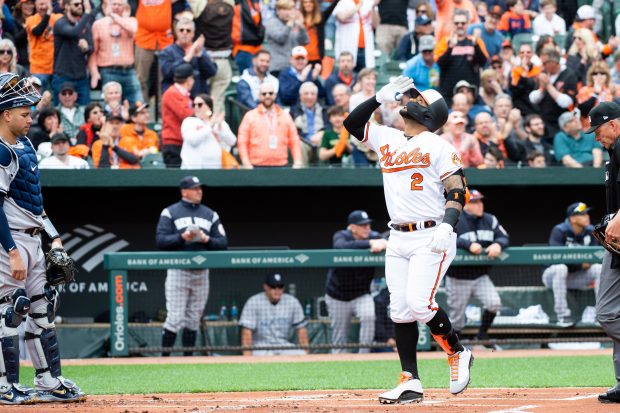Take Me Out to the Ball Game Soon
Feature photo: 2019 Baltimore Orioles Home Opener April 4, 2019. (Mike Jordan)
BALTIMORE – The first time my father took me to a major league baseball game, at the old Memorial Stadium on 33rd Street, I thought I was entering a kind of holy place.
I looked up at the enormous metal plaque above the entrance, which said the ballpark was dedicated to all those who’d made “the supreme sacrifice” in the world wars “to preserve equality and freedom throughout the world.”
And then, in the closing line that stopped everyone in their tracks, it read, “Time will not dim the glory of their deeds.”
The experience felt a little less spiritual over the next two hours that night, as my Baltimore Orioles lost to the New York Yankees, 6 to 0. Whitey Ford pitched a three-hitter. Mickey Mantle hit a moon-shot home run which landed, I’m pretty certain, somewhere on Greenmount Avenue.
But the night sanctified a spiritual experience beyond the dismal final score. This was the mid-1950s, in the infancy of Orioles’ history. It connected me with baseball itself, which connected me fully with my home town, and with all the thousands whose sports loyalties mirrored my own.
In those days, baseball was still called the national pastime. The game started losing that title a few years later, when a team called the Baltimore Colts suddenly turned pro football into the national obsession with their legendary Sudden Death championship game victory.
But baseball had a chance to get back some of its stature, in this summer of plague, until they blew it. They could have had the national sports stage all to themselves. They could have reminded us of the game’s place in our national culture, by opening play this coming July 4 or earlier, with patriotic banners flying at all ballparks, and no other major sports in action to gum up the TV choices.
So much good cheer, at a time when everyone’s so hungry to bring back a sense of national normalcy.
But, leave it to baseball to commit another in a series of unforced errors. They’ve been trying to work out playing conditions since the coronavirus hit. What the players want, the owners don’t want. What the owners want, the players don’t want. Or the commissioner doesn’t want.
What the fans want, we aren’t going to get. Obviously, we’re not getting a full season. For a while, there was talk of 114 games. Then, 82 games. The last I saw, they were talking about 60 games, plus playoffs. But, at this point, who knows?
At week’s end, the Major League Baseball Players Association issued a statement declaring, “MLB has informed the Association that it will not respond to our last proposal and will not play more than 60 games. Our Executive Board will convene in the near future to determine next steps.”
Meanwhile, time slips away.
And so does memory of a time when baseball held such a central part in the nation’s sports culture. In those long-ago days, you’d go into any neighborhood and find kids playing baseball, or variations of it if they didn’t have enough players: stickball, step baseball, running bases, three flies in, punchball.
Does anyone still see kids playing those games?
You went into any drug store and found “Baseball Digest” and “Sport” and “Sports Illustrated.”
Does anyone see kids reading those magazines? Are they still in print?
Boys grew up reading John R. Tunis’ baseball books – “The Kid from Tompkinsville,” “World Series,” “The Kid Comes Back,” or Duane Decker’s baseball series.
Does anyone see kids reading baseball books today?
Back then, the Little League and Pony League fields were filled everywhere.
You want a picture of springtime in Baltimore back then? I played a couple of years in the Howard Park Little League, with games at Conlin Field, just off the Forest Park golf course, or Sloman field, a crowded series of diamonds over at Leakin Park.
We opened each season with a parade through the streets of northwest Baltimore. We were all decked out in our team uniforms. The parades felt like something sprung to life from Saturday Evening Post magazine covers, courtesy of Norman Rockwell, with parents waving from front porches as though welcoming sons home from war.
Even at that age, I was aware of taking part in a cultural ritual, which connected parents with kids, and baseball with America. And each of us, in our uniforms, with our high-topped sneakers and our Topps bubble gum masquerading as chewing tobacco and our Brooks Robinson gloves, was being initiated into that culture.
It’s gone now. It’s been gone for years and years. But baseball could have gotten a piece of the emotional connection back this summer, if they’d only found a way to settle some of the money issues and other stuff, and taken the field.
The grandstands would have been empty, but the TV watching would have been enormous. We need a restoration of our national sense of play. Football and basketball are still off in the wings, and the very nature of their games makes them iffy with this coronavirus.
But the very rules of baseball might make the game workable. It’s all about one man at a time, separate from other players, doing his job.
And reminding us, in this joyless summer, of a time when the game was at the very center of American sporting life, and bringing a sense of those heartfelt ties back to life.

Michael Olesker, columnist for the News American, Baltimore Sun, and Baltimore Examiner has spent a quarter of a century writing about the city he loves.He is the author of several books, including Michael Olesker’s Baltimore: If You Live Here, You’re Home, Journeys to the Heart of Baltimore, and The Colts’ Baltimore: A City and Its Love Affair in the 1950s, all published by Johns Hopkins Press.

